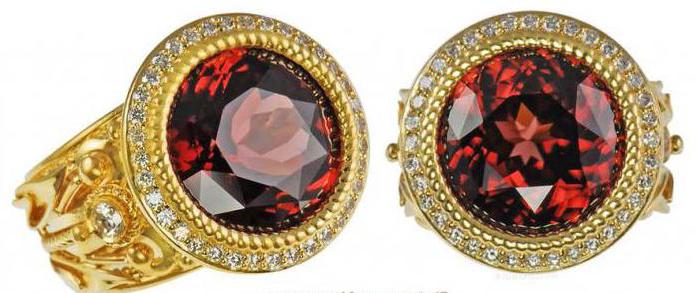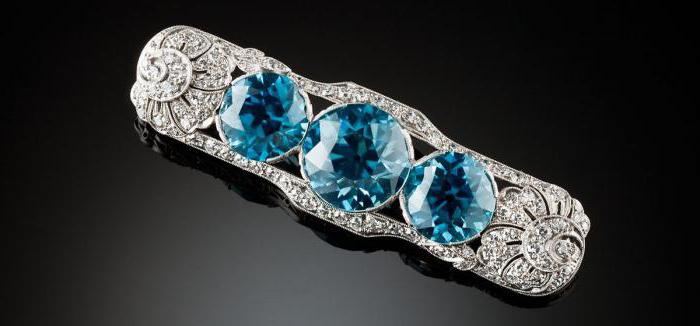Let's take a closer look at the wonderful "golden" stone, which is called zircon. Consider it from a variety of facets - from the scientific and aesthetic, practical and magical. And let's start, as usual, with a common popular characteristic.
Zircon is ...
The name of the stone comes from the German Zirkon, which, in turn, has in its origin the Persian گرگون ("zargun"), which means "golden". The stone got such a name because of its widespread attractive honey color. Zircon, depending on impurities, can have different colors. In addition, modern processing methods allow zircons to acquire various shades.
Zircon is a high-quality gem, a natural stone, which for its characteristics (amazing refractive properties) is often referred to as the "younger brother" of diamond. This mineral belongs to a subclass of the so-called island silicates. Its official name is zirconium orthosilicate, the formula is ZrSiO 4 . The stone is characterized by the content of a certain fraction (about 4%) of hafnium, which isomorphically replaces zirconium in the crystal lattice of the mineral. It is this rare-earth metal that gives zircon greater strength and is comparable to diamond shine. Some minerals also contain impurities of iron and / or manganese.

The most common color of zircons is yellow-golden. Depending on the saturation of the shade, you can find soft yellow, warm brownish, brown-scarlet stones. Nature can also please green and red zircons. But the most amazing and valuable are crystal clear, colorless zircons. Opaque and translucent varieties can also have no color. However, rare colorless zircons have a significant minus - they are extremely sensitive to gamma radiation and heat. Such an impact can fundamentally change their characteristics and structure.
Other names for zircon: azorite, hyacinth, yargun, hussakit, Engelhardite, zirconium.
Zircon Properties
Imagine a brief physical description of zircon:
- Formula Mineral: ZrSiO 4 .
- Density: 4,680-4,710 g / cm³.
- Syngonia: crystallizes in tetragonal syngony, with the formation of prismatic and dipyramidal crystals.
- Hardness (Mohs scale): 7.5.
- Shine: strong, diamond.
- Cleavage: imperfect according to (100).
- Trait color: White.
- Kink: conchoidal.
- Special properties: fragility.
Usually this mineral is radioactive - it contains impurities of thorium, uranium and rare earth elements.
Zircon, zirconium, cubic zirconium
Often, the terms listed in the subtitle cause confusion - many consider them synonyms. However, this is not so at all - each concept hides an independent object:
- Zircon is a unique natural mineral of various colors and shades, forming irregular grains and single crystals, sometimes radially intergrowths. Its formula: ZrSiO 4 .
- Zirconium is a metal with the designation Zr in the periodic table. As can be seen from the formula, it is included in the zircon crystal lattice.
- Cubic (cubically stabilized) zirconium, better known as cubic zirconia. Great confusion is caused by the English name - Cubic Zirconia. Zirconia, in contrast to zircon, is an artificial, synthetic crystal. Its name, by the way, is the abbreviation of the institution where the "zirconia cube" was first grown - the Physical Institute of the Academy of Sciences. The formula for this artificial diamond is CZ (ZrO 2 ).
Varieties of Zircon
Looking at the color of zircon in the photo, you can easily determine the variety of a particular mineral:
- Matara diamond (matura diamond, matar diamond). The name comes from the toponym where these gems are mined (region in Sri Lanka). The rarest zircon is absolutely transparent and colorless. In addition, the mineral has an almost diamond luster. Today, scientists have learned how to obtain matara diamonds, exposing zircons of other species to special gamma radiation.
- Malacon. This is the name of zircon, which has a warm dark brown hue. May be radioactive.
- Jargon (Siamese zircon - because it is mined in Thailand). Under this name crystals of piercing lemon color are hidden . Solar, smoky yellow, straw-colored minerals are also quite appropriate to attribute to jargon.
- Hyacinth. This gem-zircon is red, pink, raspberry and even orange, brownish (lat. Hyacinthus) color. Stones of such shades were named because of their resemblance to hyacinth petals.
- Yatsint. The name of the zircons is orange-red.
- Starlit. So called only ennobled (by heating) the stone, which as a result of the impact gets a wonderful blue or blue color.
- Green zircon. The gem does not have a certain beautiful name; its feature - may contain radioactive microparticles of uranium.

Zircon: how to distinguish a fake
Here are a few ways to help determine the authenticity of the gem:
- Most stones contain radioactive elements, so a device showing the level of radiation can help you make the right choice.
- Since zircons are most often referred to as zircons, remember that a natural gem has a much lower density than an artificial “zirconia cube”, which is why it weighs less than a fake.
- Zircon has a brilliance of diamond, but it is given out by resinous shades of inclusions.
- In contrast to the same cubic zirconia, transparent zircons are very rare. In addition, matara diamonds (transparent zircons) will not be homogeneous - you will definitely see small inclusions, voids, etc. in their bodies. But artificial cubic zirconia is pristine, transparent and homogeneous.
Origin and deposits of zircons
The gem has a magmatic origin, is found in the body of pegmatites, granites, syenites, and others. In igneous rocks, zircon acts as an accessory mineral. Since many crystals contain a sufficient number of radioactive microparticles, the latter as a result of their decay can destroy the structure of zircon, making it metamict. If the rocks enclosing the zircon are eroded, then the mineral can be found in placers.
The largest zircon deposits are located in:
- Sri Lanka;
- Burma
- Thailand
- Vietnam
- Madagascar
- Canada
- USA;
- Brazil
- Australia
- Norway
- Tanzania
- Cambodia.
In Russia, zircon is mined in Yakutia, the Urals and the Kola Peninsula.
Zircon application
We list the main areas of production where this wonderful gem is useful:
- Jewelcrafting. Alas, now zircons are increasingly being replaced by artificial cubic zirconias. The reason is that the yargun due to its low density is a rather fragile material, which is why it is often damaged during processing. Therefore, zircon lovers prefer to buy antique jewelry sparkling with natural gems.
- Production of fireproof and refractory structures.
- It is used in industry as a source of zirconium, hafnium, uranium and valuable rare earth metals.
- Due to the high uranium content in zircon crystals, the latter is used as a mineral for determining the age of rocks using the uranium-lead dating method.
The healing properties of the gem
Ancient beliefs attribute to the mineral the following amazing healing properties:
- Jargon (yellow zircon) helps people suffering from diseases of the heart, stomach, liver. Also, such stones are useful for kidney diseases - they supposedly help to remove excess fluid from the body.
- Earrings with zircon contribute to the fight against dry skin, fine nets of wrinkles, and skin diseases.
- Starlit has a beneficial effect on those with diseases of the thyroid and pancreas and even helps to recover from a brain tumor. It is also considered the best gift for dieters - a stone reduces appetite and fights excess weight.
- Zircon has a positive effect on the pituitary gland, the work of the gastrointestinal tract, as a whole it energizes a person and helps to achieve emotional balance.
- Products made of silver, zircon relieve insomnia, and sleeping - from nightmares.
- Hyacinth in ancient times was a contraceptive. The stone was heated and daily kept in the lower abdomen for 2-3 hours. The procedure was repeated for 8-10 days. But nonetheless, nothing is known about its success.

Zircon and Astrology
It is believed that zircon is a projective Yang, because the stone not only releases life-giving energy, but also activates it. The mineral acts on the parietal chakra - Sahasrara.
The crystal patronizes the bearers of the names Nina and Anastasia. Those born under the signs of the elements of water, earth, fire and air should choose the shade of their zircon guardian, based on the color of the element. The planet of the stone is Jupiter, therefore, to ward off its aggression, you should wear a bracelet or ring with zircon on your left hand.
Stars do not recommend wearing the gem to Cancer and Aries, but for Sagittarius and Aquarius this is the best purchase.
The magical properties of stone
Two thousand years ago, during the time of the poet Ovid, it was believed that zircon makes any woman attractive and sexy. Indian yogi practitioners claim that the gem in the literal sense of the word saturates a person with life-giving bio-energy, overtaking all other stones in this property. Modern psychics believe that amulets with zircon not only protect them from dark entities, but also increase the magical power at times.
According to popular beliefs, jargons bring wisdom and luck to their owner, and a zircon ring not only protects from the evil eye and the curses of enemies, but also helps to make a difficult decision - just touch the stone with your finger. Starlites are recognized guardians of travelers, helping the latter to return home safe and sound. It is also believed that it is zircon that can eliminate the discord between the soul and body.
Rocket "Zircon"
Some people know the Zircon of a qualitatively different kind - the Russian anti-ship maneuvering hypersonic cruise missile. Its first test was carried out in 2016, and in 2017 it is planned to begin mass production of such missiles. The Russian Zircon will be adopted by 2018, replacing it with the P-700 Granite.
The rocket has the following significant characteristics:
- launch range: 350-500 km;
- speed: 8 sound speeds;
- body length: 8-10 m;
- guidance: homing head + inertial navigation.
Zircon is a beautiful gem of eye-pleasing colors, striking with diamond brilliance. The crystal is used not only in jewelry, but also in various other industries. In addition to all its visible advantages, folklore endowed the mineral with various magical and healing properties.